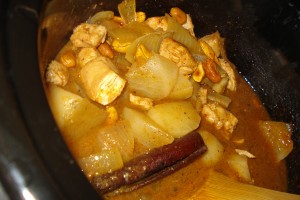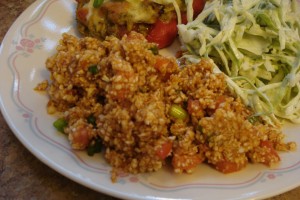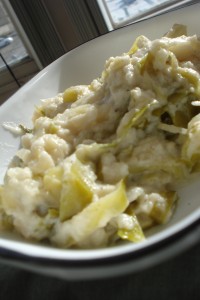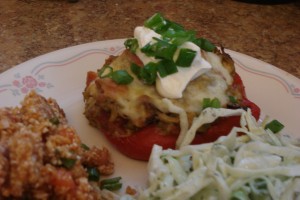My general culinary mindset over the past ten or so years has moved progressively in the direction of being lower and lower carb. Even if I don’t always use the substitutions I discover, my mind is always striving toward finding a logical and tasty low-carb substitute for foods that I eat. In recipes, even when I don’t eliminate carbs completely, I will reduce, for instance, using one tablespoon of sugar, rather than two. Some substitutions have proven to be more trouble than simply eating the carb less often-making cauliflower rice is such a to-do that I simply eat real rice, but on fewer occasions. But there is one carb for which there is no reasonable substitute; I only eat is once or twice a week on “cheat” days, but it is such a stronghold of my culinary repertoire, I simply cannot abandon it in my regular diet.
Pasta.
My relationship with pasta began with the common childhood infatuation with macaroni and cheese, but it has evolved to the point where pasta dishes are one of my strongest aptitudes in the kitchen. Somewhere along the line, I reached a threshold where I stopped ordering pasta at restaurants altogether because I could make any of my favorite pasta dishes easier and cheaper at home. The only time I eat pasta at a restaurant is when they make fresh pasta in-house; I do make my own fresh pasta at home on occasion, but it’s enough of a production to merit an appreciation of the restaurant variety.
But when it comes to any dish made with boxed store-bought pasta, my kitchen is the the only source. In part, it’s because I know every restaurant that serves boxed pasta is buying it for $1 from the same grocery store I am—that voluminous plate of pasta for $18 at your favorite mid-scale restaurant is a much bigger value-cheat than the $32 crab cakes.
More and more, however, the larger issue at hand is a particular proclivity I have developed over the years—I am an extreme al dente snob. It started when I spent a summer in college as roommates with a Mediterranean gal. It’s only grown since then. I like my boxed pasta extremely al dente. Fresh pasta is another story completely—I can enjoy a doughy fresh ravioli because it’s a completely different context. Only boxed pasta carries with it the culinary promise of al dente in the extreme.
Most pasta recipes I find online are a “no sweat” version of something I’ve tried before, or at the very least a novel re-combination of ingredients I’ve used before: “Okay, cool, so they put chicken in that…” or “…mushrooms in that…” etc. or “That’s a neat combination of spices, I’ll have to try that…”
This week, however, I ran into a recipe for a pasta dish that’s a bit apart from what I’ve tried before. It’s not so much that the methods were especially new or tricky (it’s not like we’re talking true from-scratch carbonara), but rather the ingredients were of a special caliber. At it’s heart, it’s a basic cheese-based cream sauce with stuff added. But the obtaining of the stuff was something of a challenge—many of the headlining ingredients were not available at my grocery darling, the Aldi. And many of the key ingredients were higher-brow. This was a luxury pasta dish, not an average Friday night pasta dish. That’s not to say I would pay $18 for it at a restaurant, but it presented an exciting project for my weekday grocery runs and my weekend test-kitchen.
Some ingredient notes. Scarmorza, as it turns out, is a particular type of Italian cheese that is similar to mozzarella and is often, but not always, smoked. In all the recipes I found for this dish, the smoke-flavor component was a large part of the taste-profile. Additionally, most recipes simply called for smoked mozzerella—which was hard enough to find, let alone a trip down to the Strip district in search of true scarmorza. And so, fresh smoked mozzerella is the key cheese in my recipe.
Secondly the recipe calls for peas, but I am not a fan of peas. I substitute shelled edamame for peas in most other recipes, and so I did the same here.
Lastly, the original recipes all call for prosciutto. But I feel like it’s something of a sin to bury prosciutto in a dish with so much other strong flavors, so I got pancetta cubes instead.
SARAH’S RIGATONI ALLA SCARMORZA
2 tablespoon unsalted butter
one medium onion, diced
2 cloves garlic, minced
1/2 cup dry white wine
2 tablespoons flour
2 cups half & half or heavy cream
1 teaspoon salt
1 teaspoon fresh black pepper
1/2 cup Parmigiano-Reggiano, grated
1/2 cup smoked mozzarella, grated
1/4 cup pancetta or prosciutto, diced
1/2 cup peas or shelled edamame
1/2 cup pistachio nuts, coarsely chopped
Fresh cracked black pepper
1 pound rigatoni pasta
Melt butter in a medium saucepan. Saute the onions until soft. Add the garlic. After a few minutes, deglaze with the wine. Add flour and stir until onions and garlic are coated. Add cream, salt, pepper, and cheeses. Once cheeses have melted, process with an immersion blender until smooth.
Meanwhile, cook the peas or edamame, if needed. Cook the pasta to desired done-ness. Drain the pasta and toss with sauce, peas/edamame and pancetta/proscuitto. Garnish with chopped pistachios and fresh ground pepper. Serve and enjoy!
This recipe turned out quite well, and I will likely make it again. However, I will note that it turned out well in an entirely predictable way. My pasta-with-cheese-sauce skills are pretty solid, and this dish was as good as any other that I make regularly. The extra ingredients—pistachios, pancetta, edamame—added some pleasant flavors, texture and color to the dish. But ultimately there was nothing about this dish that turned out especially amazing or surprising. It was worth the trouble of hunting down some harder-to-find ingredients, but in my opinion would not be worth $18 a plate at your local Italian eatery.





